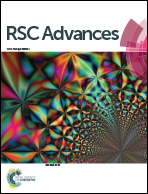One-pot preparation of pomegranate-like polydopamine stabilized small gold nanoparticles with superior stability for recyclable nanocatalysts†
Abstract
A pre-mixing and post-polymerization strategy has been developed for one-pot preparation of pomegranate-like polydopamine (PDA) stabilized small gold nanoparticles (AuNPs) with sizes smaller than 5 nm in aqueous media. Firstly, the pre-mixing of dopamine (DA) and HAuCl4 was used to generate the Au clusters as nucleating seeds. Secondly, the rapid self-polymerization of DA into polydopamine (PDA) and simultaneous Au redox reaction were initiated when the pH of the reaction system was tuned to 8 by the injection of a NaOH solution into the mixture, leading to the formation of the pomegranate-like PDA–AuNPs nanocomposites with small AuNPs well dispersed inside. The as-prepared nanocomposites exhibited superior stability in high saline conditions (500 mM NaCl) and were able to be coated onto a filter paper to form paper catalysts, which were used as recyclable catalysts for the reduction of high concentrated (50 mM) 4-nitrophenol (4-NP) with a TOF of 1006 h−1.


 Please wait while we load your content...
Please wait while we load your content...